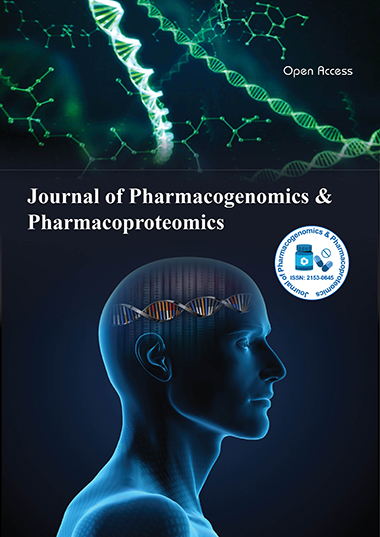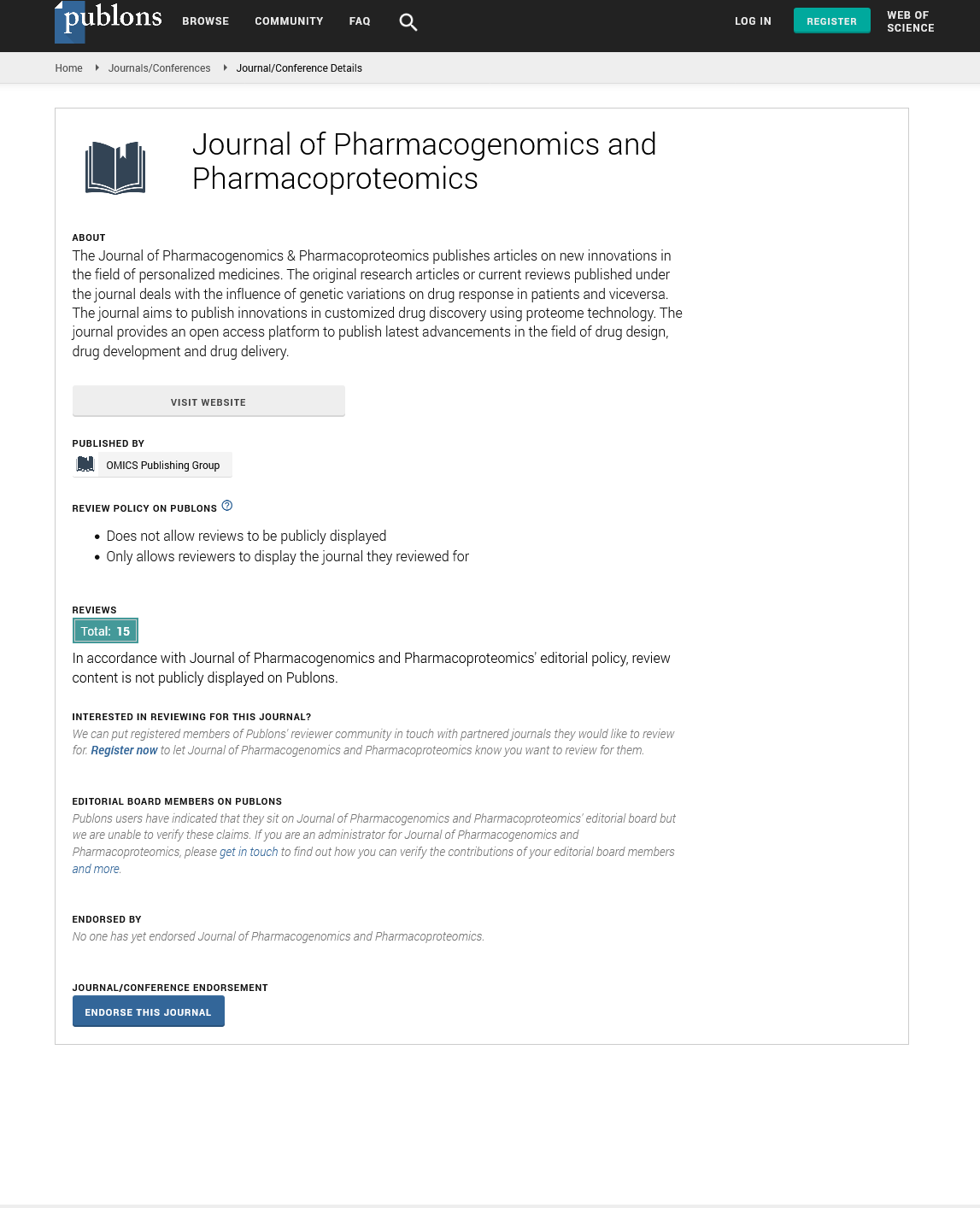Indexed In
- Open J Gate
- Genamics JournalSeek
- Academic Keys
- JournalTOCs
- ResearchBible
- Electronic Journals Library
- RefSeek
- Hamdard University
- EBSCO A-Z
- OCLC- WorldCat
- Proquest Summons
- SWB online catalog
- Virtual Library of Biology (vifabio)
- Publons
- MIAR
- Euro Pub
- Google Scholar
Useful Links
Share This Page
Journal Flyer

Open Access Journals
- Agri and Aquaculture
- Biochemistry
- Bioinformatics & Systems Biology
- Business & Management
- Chemistry
- Clinical Sciences
- Engineering
- Food & Nutrition
- General Science
- Genetics & Molecular Biology
- Immunology & Microbiology
- Medical Sciences
- Neuroscience & Psychology
- Nursing & Health Care
- Pharmaceutical Sciences
Opinion Article - (2025) Volume 16, Issue 1
Impact of CYP2D6 Polymorphism on Tamoxifen Efficacy in Estrogen Receptor-Positive Breast Cancer
Elise Marquet*Received: 26-Feb-2025, Manuscript No. JPP-25-29328; Editor assigned: 28-Feb-2025, Pre QC No. JPP-25-29328(PQ); Reviewed: 14-Mar-2025, QC No. JPP-25-29328; Revised: 21-Mar-2025, Manuscript No. JPP-25-29328(R); Published: 28-Apr-2025, DOI: 10.4172/2153-0645.25.16.126
Description
Tamoxifen is widely recognized as a cornerstone endocrine therapy for estrogen receptor-positive breast cancer in both premenopausal and postmenopausal women. Functioning as a prodrug, tamoxifen requires hepatic conversion into active metabolites primarily 4-hydroxytamoxifen and endoxifen to exert its therapeutic effect. This metabolic conversion is principally mediated by the cytochrome P450 2D6 enzyme, a polymorphic gene product that plays a pivotal role in determining patient- specific drug response and clinical outcomes.
CYP2D6 is characterized by a high degree of genetic variability, with allelic differences producing a spectrum of enzymatic activities classified into four phenotypic categories: poor, intermediate, extensive and ultra-rapid metabolizers. Patients with poor metabolizer status, often associated with nonfunctional alleles like *3, *4, *5, or *6, display a significantly impaired ability to metabolize tamoxifen into its active forms. As a result, such patients may experience insufficient endoxifen levels, diminishing the drug’s anti-estrogenic effect and potentially increasing the risk of breast cancer recurrence.
Clinical investigations have attempted to clarify the association between CYP2D6 genotype and tamoxifen treatment efficacy. A notable retrospective study from Germany, involving over 1,200 patients, demonstrated that poor metabolizers had a 2.5 times higher recurrence rate compared to extensive metabolizers. Intermediate metabolizers also faced compromised progression- free survival, suggesting a dose-response-like relationship between enzymatic activity and therapeutic success. These findings highlight the importance of pharmacogenomic profiling in maximizing the benefits of tamoxifen therapy.
However, the clinical consensus on the predictive utility of CYP2D6 genotyping remains unsettled. While some studies affirm a strong correlation between reduced CYP2D6 activity and adverse treatment outcomes, others have failed to replicate such associations. Variability in these findings may be attributed to inconsistent genotyping techniques, variations in patient adherence, or the influence of concomitant medications— particularly Selective Serotonin Reuptake Inhibitors (SSRIs) such as paroxetine and fluoxetine, which are known to inhibit CYP2D6 and may further lower endoxifen levels.
Due to these inconsistencies, CYP2D6 genotyping has not yet been universally adopted into routine clinical workflows. Despite the publication of guidance by organizations like the Clinical Pharmacogenetics Implementation Consortium (CPIC), many oncologists remain hesitant, citing limited accessibility to testing, cost constraints and mixed clinical trial evidence. Nonetheless, interest in individualized treatment strategies is growing, particularly among patients with unpredictable therapeutic responses or those on prolonged endocrine therapy regimens.
Pilot initiatives in Europe have begun to explore the practical application of CYP2D6 testing in clinical oncology. At the Bordeaux Center for Precision Medicine, a prospective cohort of 190 breast cancer patients underwent genotyping before initiating tamoxifen therapy. Based on genotype, poor metabolizers were offered alternative hormonal treatments such as aromatase inhibitors or adjusted tamoxifen dosing. Interim results indicated improvements in plasma endoxifen levels and patient-reported quality of life, lending credence to genotype- guided therapy optimization.
In parallel, research in Pharmacoproteomics is expanding the understanding of tamoxifen metabolism beyond genomics alone. Proteomic analyses of breast tissue and circulating plasma have revealed patient-specific variability in CYP2D6 expression levels, reinforcing the value of a combined genotypic and proteomic assessment. This integrated approach could enhance therapeutic precision by accounting for both inherited and acquired factors that influence drug metabolism.
Emerging strategies are also focusing on bypassing the CYP2D6 pathway altogether. Direct administration of endoxifen and the development of tamoxifen analogs that do not require metabolic activation are under clinical investigation. These novel agents could provide effective alternatives for patients with inactive CYP2D6 alleles, thus eliminating the risk of suboptimal drug metabolism and ensuring more consistent therapeutic outcomes.
CYP2D6 genetic variability is a key determinant in the metabolic activation of tamoxifen and significantly impacts clinical outcomes in hormone-responsive breast cancer. While challenges related to clinical implementation persist, accumulating evidence supports the integration of pharmacogenomic testing into individualized care models. As the field of precision oncology advances, CYP2D6 genotyping is poised to become an essential tool in the effort to refine and personalize breast cancer treatment strategies.
Citation: Marquet E (2025) Impact of CYP2D6 Polymorphism on Tamoxifen Efficacy in Estrogen Receptor-Positive Breast Cancer. J Pharmacogenom Pharmacoproteomics.16:126.
Copyright: ©2025 Marquet E. This is an open-access article distributed under the terms of the Creative Commons Attribution License, which permits unrestricted use, distribution and reproduction in any medium, provided the original author and source are credited.

